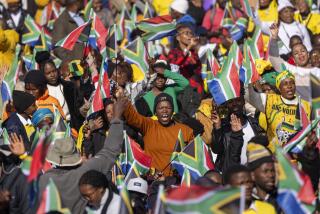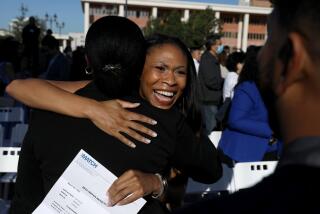Apartheid Fever Infects Medical Schools
- Share via
SOWETO — A burgeoning issue among the ongoing troubles in South Africa is the dissatisfaction of black students with what they call “apartheid education.” The lastest dispute began last month when a number of white students were admitted to the predominantly black Medical University of Southern Africa (commonly known as Medunsa). Black students mounted a boycott that erupted into a full-scale riot and forced the school to close for a week.
Both black and white South Africans were astonished at this apparent reverse racism, but the issue goes far deeper than that.
The boycott of classes began in early March when black students discovered that seven white medical students had been admitted to the school, which has an enrollment of about 1,200. Even the students’ representative council had not been informed of the decision.
The student body demanded that the whites withdraw from the school, and when that failed the boycott began. The university expelled the white students and classes resumed. But two of the white students appealed to the Supreme Court, which nullified their expulsion, and the boycott was on again. On April 14, violence erupted on the campus and the 1,078 black students involved were suspended. One of the white students then voluntarily withdrew, leaving only one other white student enrolled.
Many people regarded the protests as inexplicable. The move to open Medunsa to all races was seen as progressive, and the university’s public relations officer even said that the college council had decided to admit students of all races after realizing that the future of South Africa would have to be “non-racial.” Such sentiments, taken at face value, led many people to believe that the university had taken a step that should be taken by other institutions. But a look at the students’ arguments and the overall treatment of black education, provides a different perspective.
Medunsa was established eight years ago to train black doctors only, as part of the government’s apartheid policy. The government wanted to discourage white universities from admitting black students. It also wanted to close the black medical school at the white University of Natal. Most doctors and educators opposed the creation of Medunsa, arguing that the existing five white medical schools should instead be opened to blacks. The government, however, did not agree but it did allow the black medical school at Natal to remain open.
When Medunsa opened, its governing board was loaded with apartheid ideologists, and they still control the school. So when this latest move to bring in white students was painted as “progressive,” the black students refused to buy it. The students reasoned that since apartheid is as entrenched as ever, since double standards in education still prevail and the shortage of black doctors remains horrendous, why should the admission of whites to their school be regarded as progress?
In 1983 there were 765 white medical school graduates in South Africa, compared to 184 blacks. The same year 754 whites were accepted into medical school programs compared to 275 blacks. In 1984 there were 19,294 doctors of all races registered with the South African Medical and Dental Council. The council will not provide racial breakdowns of its members, but according to independent research only 3,000 of those doctors--at most--are black.
Soweto, with a population of nearly 2 million, has only 23 doctors.
Certainly, there is an urgent need to integrate education, but white educational institutions should admit blacks. While white liberal universities officially have opened their doors to blacks, they actually admit very few of them. For example, in 1983 the medical schools at the universities of Witwatersrand and Cape Town jointly admitted 59 blacks, compared to 300 whites.
This is not necessarily caused by racism in the selection process, but it is the result of the affects of racism in undergraduate education. Whites receive far better schooling than blacks, making whites better prepared for admission to medical schools. Thus Medunsa, in opening its doors to white students who have numerous alternatives, is denying some black students their already very slim chance of becoming doctors.
Another reason for the Medunsa students’ outrage was the fact that the white applicants who triggered the furor had failed the entrance exams at white medical schools. So as is the custom in South Africa, blacks were being used for white ends, but white medical schools certainly would not make such allowances for inferior black students.
The incident also was upsetting to the black students because it was a telling comment on the standards and training offered by Medunsa--and yet another slap in the face by the whites who control the school.
The Medunsa debacle has illustrated a salient point that white South Africa needs to recognize. A truly multiracial educational system must work both ways: Not only must black schools be open to whites, but white schools also must be open to blacks--from elementary schools through the university level.
More to Read
Sign up for Essential California
The most important California stories and recommendations in your inbox every morning.
You may occasionally receive promotional content from the Los Angeles Times.













